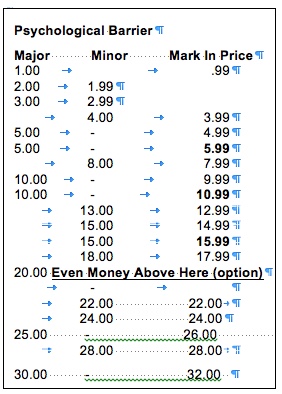2017: Psychological Pricing for Perceived Value
by Sid Raisch and Steve Bailey

READ FIRST: "Prices should be set based on your ability to create a value perceived by your customer, instead of the common practice of applying a simple mathematical factor to the cost of goods."
This is a very quick and powerful guide to retail pricing based upon the value you create as perceived by your customer. The perception of value is created partially by the price itself.
Perceived value is highly subjective and is influenced by the quality of goods, merchandising, store environment, value added service, and price presentation.
Typically, this is influenced downward by the sellers biased knowledge of the cost of products. Increase value perception and adjust your pricing up until resistance to your price cannot be overcome by creating additional perceived value. Then, if necessary lower the price until sales begin to flow. Try a price based on comparison to other retailers selling the same product in similar situations adjusted to your ability to enhance the perceived value.
Once you have priced according to perceived value, check to ensure you do not lose money at that price. A Margin Floor should be established based on actual or budgeted revenue and costs of doing business. These costs should include profit, wages & wage benefits, operating expenses, and cost of goods sold (including freight). All forms of shrink must be accommodated including markdowns, discounting, coupons, bonus bucks, theft, internal use, donation, etc. Refrain from buying products that do not allow you to recover all of these costs of doing business in your price. There are typically very few “KNOWN PRICE” items sold in garden centers. For those very few items sacrificing some margin contribution may be useful, with a lower than full perceived value price point to remain perceptively competitive.
The chart below indicates price marks that have been proven to be perceived by consumers to be the “same as” lower prices that have been omitted from the “Your Mark” column. The premise is that consumers “read” a price the way they want to, reducing their resistance to your price.

New Psychology? Over time consumers have become more aware of 99-cent price points and have begun to “round-up” at major price barriers such as 4.99 to 5, and 9.99 to 10. Therefore, it is possible to pick up additional margin dollars at marks such as 5.99, 10.99, etc.
Major Barrier Option: Eliminate minor price points. Round up from minor barrier marks to major barrier marks (bold) when possible to pick up additional margin dollars.
Recommended Even Money Option: The consumer “thinks” that you know the price you need. Above 18.99 drop the 99 cents to reduce a linguistic problem that adds little to the total sales while picking up several margin dollars. Bump up to even prices avoiding X5 and X9. IE: 42, 44, 56, etc.
Dollar Signs Gone: Recent research has shown that prices without the $ sign appear to be lower.
Want a printable version of this article? CLICK HERE to download a PDF.
NOTE: Sid Raisch and Steve Bailey have collaborated on this document over the years. It is provided for information purposes only and should be used with care and with professional advisement. Use at your own risk.